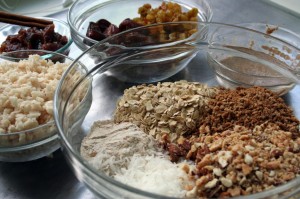Editors’ note: This is a new column we’re introducing for the summer to spice up your campfire and backcountry meals. This one comes from Kelsey Dayton, a Lander freelance writer who used to live and play in Jackson Hole.
It’s official. Summer has arrived. The wildflowers are blooming, the snow is melting, and its time to hit the trails.
This summer, get more creative than gels and dehydrated meals. Dishing will provide you some recipes to liven up your backcountry cuisine, starting this week with snacks.
To get you started, we enlisted the help of Claudia Pearson, the rations manager with the National Outdoor Leadership School’s Rocky Mountain branch. If anyone knows backcountry food, it’s Pearson.
For 34 years she’s created food rations for about 2,000 students a year who spend an average of 28 days in the backcountry on courses with the National Outdoor Leadership School. Here she offers tips for planning your snacks, and NOLS shares a few of their favorite recipes for energy inducing treats to take along on your next adventure.
First, when planning your snacking, consider group size, age and gender of participants, as well as the length and nature of the trip and the climate in which you’ll be hiking, Pearson said.
Younger kids eat less than adults. Think lots of small snacks. The more arduous the trip, the more you’ll eat. Hiking in higher elevation means you’ll have less of an appetite — make sure to take your favorite foods — they’ll be easier to force down when nothing sounds that appealing.
People older than 30 tend to be pickier eaters, if your job is to plan the food, make sure you know what they like. In fact, it’s your job to know everyone’s preferences, allergies and dietary restrictions.
“If people don’t eat, that’s a recipe for disaster,” Pearson said.
To keep you eating, pick a variety of food and food you like. And don’t forget to hydrate — NOLs recommends three to four liters of water a day while on the trail
Every hiker should keep food on their body in an easily accessible area so if you get separated from the group, you aren’t separated from the snacks. And always err on the size of too much food instead. Plan on eating at least every two hours while on the trail. Make a mix of candy and nuts. Take cheese and crackers and peanut butter. Snack on summer sausage, beef jerky or cheese sticks. Or make your own energy bars or cookies.
Here are few recipes snacks courtesy of the NOLS “Cookery.” Make these at home to take on the trail, or make them at camp if you are on an extended trip.
Recipe: Katie’s No-Bake Energy Nuggets
Ingredients
- (Makes 30 bite-size nuggets)
- ½ cup sunflower seeds and/or chopped nuts
- 1 cup raisins, Craisins or small dried fruit pieces
- ½ cup hydrated granola (combine with ½ cup warm water to hydrate granola) or ½ cup cooked brown or white rice
- ½ cup nut butter (peanut, almond, or cashew)
- ½ cup powdered milk
- ½ cup honey
- 1 cup dried regular or instant oatmeal
- 1 tsp cinnamon
- A few drops of vanilla
- ¼ to ½ cup whole wheat flour
Instructions
- Mix all ingredients except flour together and stir. The mixture will be sticky.
- Gradually add flour until the mixture becomes less sticky.
- Let mixture set in a cool place- if you are camping put it in snow, under a shaded tree or rock or in or near a stream) for 15 to 20 minutes or until ingredients bind together.
- Pinch off small amounts and roll into little 2-inch nuggets.
- Store in a sealed container or plastic bag.
- These energy nuggets are very dense, so you probably only need to eat one at a time.
- Keep them as cool as possible. Eat within one to two days.
Servings: 4
Calories: 749
Fat: 29
Protein: 23














